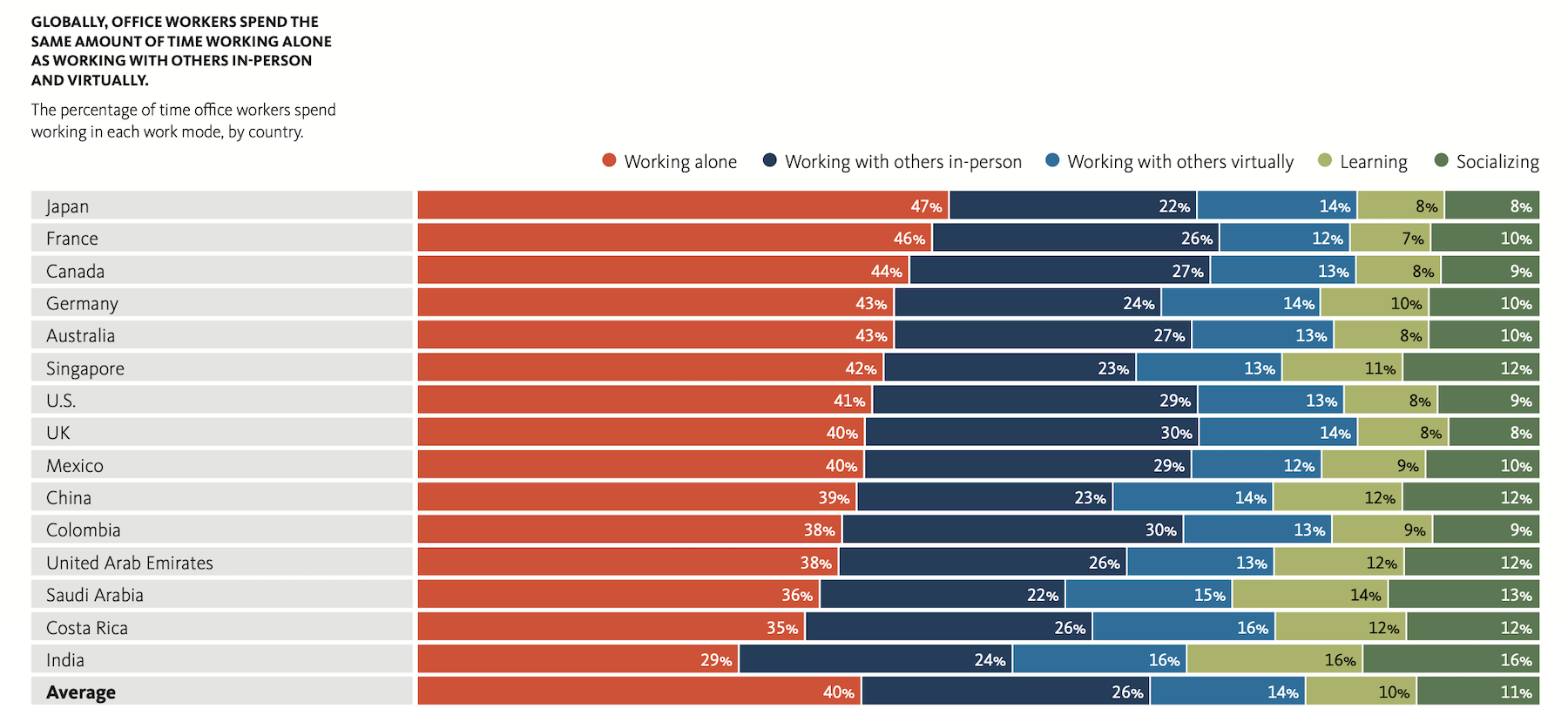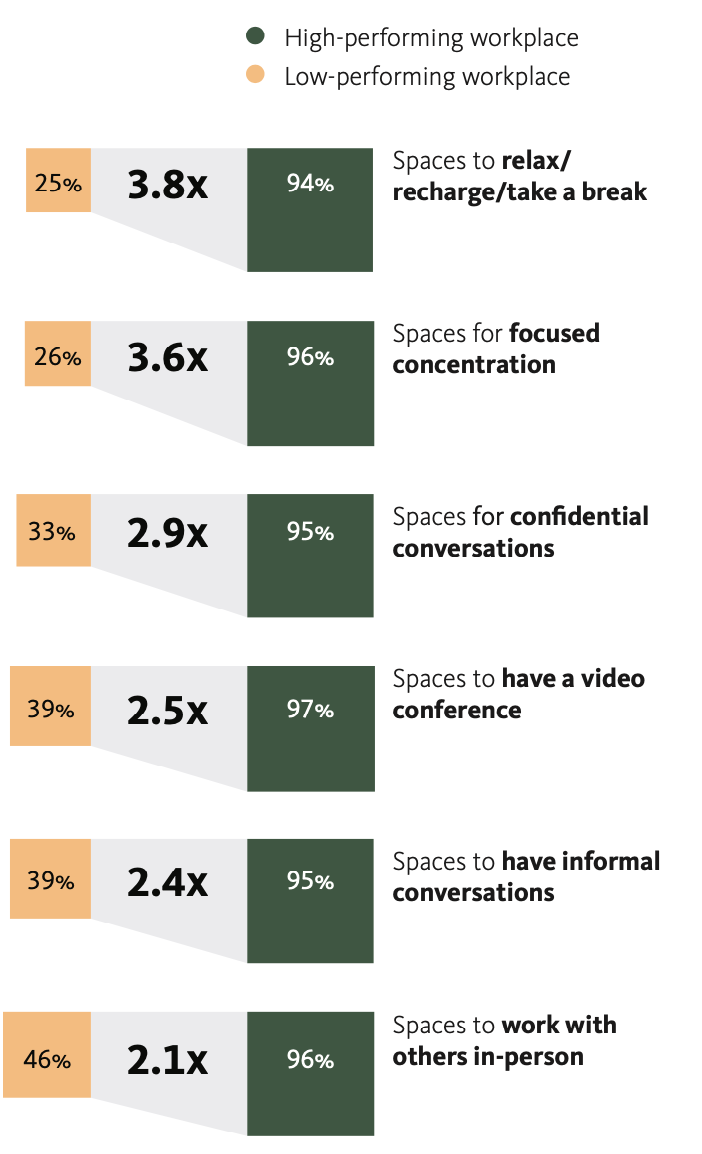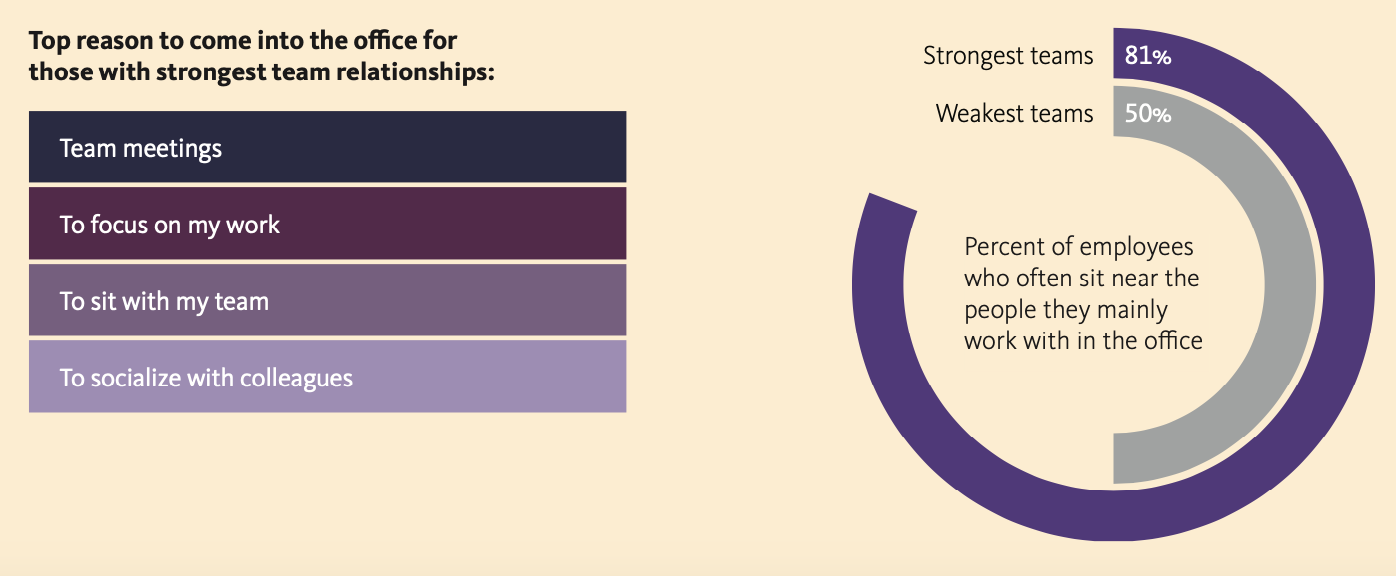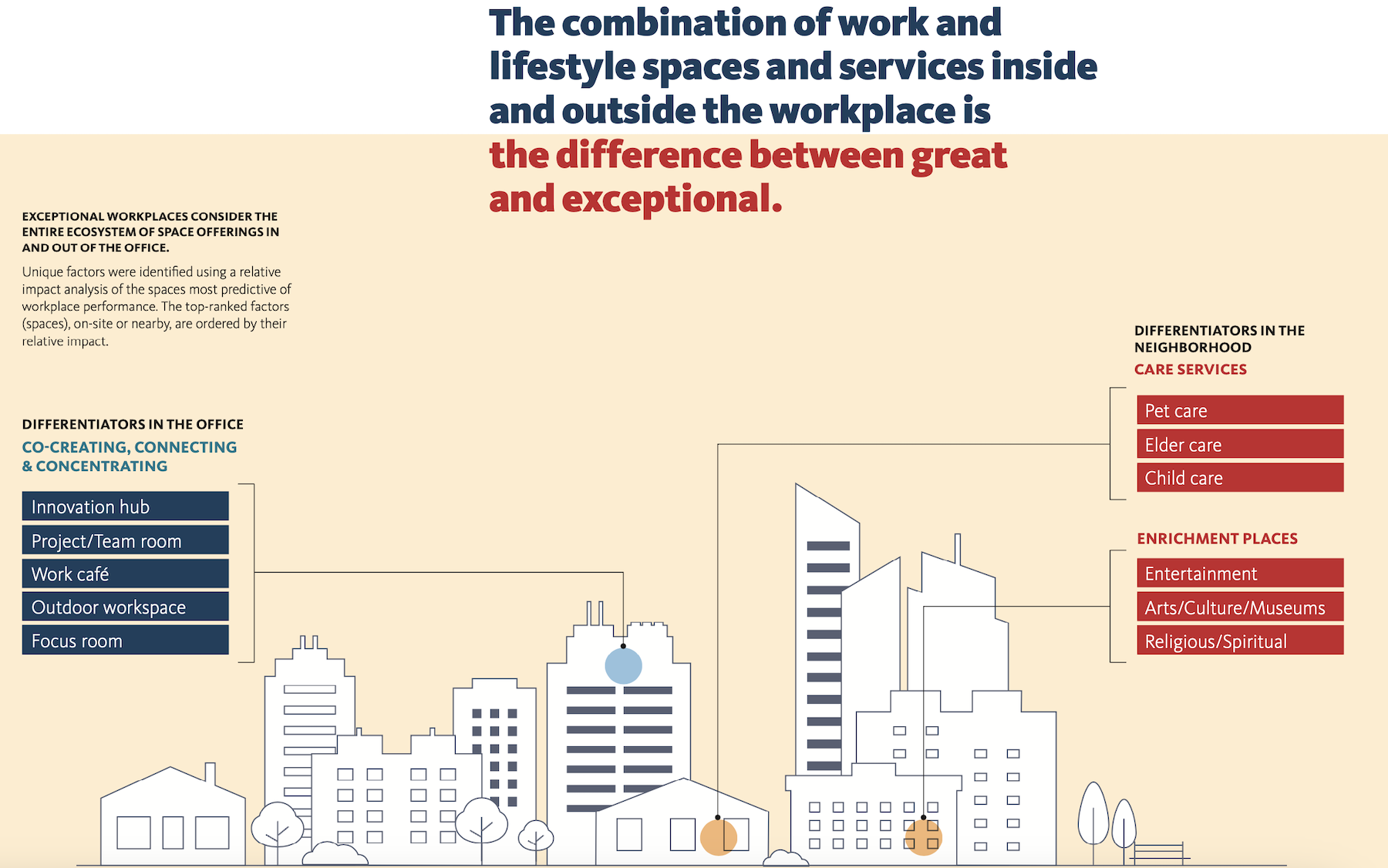For years, AEC firms and their developer clients have worked under the assumption that a good workplace is effective when it fosters working alone, with others in-person and virtually, learning, and socializing.
These factors are foundational as workplace performance indicators. “But having a good workplace is no longer enough,” states The Gensler Research Institute in its Global Workplace Report 2024, which is based on over 16,000 employee responses to a survey conducted in 15 countries and with 10 client industries. (The survey, conducted from October 2023 to January 2024, did not include fulltime remote workers.)
The report contends that employees are seeking different experiences that go beyond functional and effective office spaces, and now include feeling that the space is beautiful, welcoming, and inspires thinking. Within the office, spaces with the greatest impact on performance are innovation hubs, cafés, outdoor areas, and “focus” rooms. Beyond the building itself, exceptional workplaces leverage their surrounding neighborhoods’ amenities and services.
Gensler’s research shows, however, that many workplaces across industries and countries lag in the quality of their workplace experiences.

High-performing employees have more workplace choices
Gensler’s latest study highlights the shift, in gauging an office’s effectiveness, from real estate occupancy to people-centric performance measures, to assess the design impact on how employees work and feel in the workplace, individually, in teams, and as part of a company.

The report defines workplace performance as an average of two composite scores that measure how space supports work and how employees feel about that space. Effectiveness measures factors such as function, layout, and so forth; experience measures factors such as beauty and inspirational feelings.
Global office workers spend half of their typical workweeks in the workplace, 20% of their time at home, and 29% in other locations that might include coworking space. Pre-pandemic, this average was closer to 70% of time in the office. “Now, more than ever, the workplace needs to respond to a wider offering of spaces and experiences,” states the report, adding that employees across the world have unique and individual needs within the office.
The report looks closer at how top performing employees are experiencing their workplaces. The report scores the most-engaged individuals on factors such as how energized and happy they feel while working. Employees with the highest engagement score differ from other workers in the amount of time they spend working alone, learning, and socializing. (The report finds that these employees spend just 36% of their time working alone, versus 44% among the least-engaged employees.)

Nearly all top performers—96%––also say they have control over how they manage their time, versus half of those working in low-performing offices. Gensler emphasizes that “exceptional” workplaces offer their employees choices about where they work within the office. High-performing workplaces offer greater access to spaces for critical work activities, and overall have more work settings to choose from. This empowers the employees to work at the most effective spaces for their tasks.
It's not all about work, either. More than 90% of employees in high-performing workplaces says the office allows them to occasionally unplug from technology. And these workers also tend to use the office more for socializing and having fun.
Amenities add to workplace’s cache
Two-thirds of the workers surveyed describe their company’s office building as “one of the premium, higher-quality” commercial buildings in their areas. Gensler contends that building quality has a direct relationship to workplace quality: high-performing workplaces are twice as likely to be inside high-quality office buildings. These buildings, as often as not, are located in neighborhoods that offer diverse amenities, services, and alternate workspaces. High-performing workplaces, estimates Gensler, have access to 2.6-times as many amenity spaces on-site and 1.6-times as many amenities and services in the neighborhood. “Access to amenities and services appears to make a particular difference,” Gensler states about such “ecosystems” of spaces and experiences.

However, the report also finds that less than one-third of workplaces globally has been redesigned in the last three year, making these workplaces less likely to be able to meet the expectations of young people entering the workforce. “There’s a pressing need for organizations to intentionally rethink office spaces to boost company culture and drive business growth,” says Gensler.
Janet Pogue McLaurin, Gensler’s Global Director of Workplace Research, observes that a great workplace “must not only be a tool to get work done effectively but be intentionally designed for human emotion,” creating experiences that support new ways to work in and outside of the office.
Related Stories
| Aug 11, 2010
U.S. firm designing massive Taiwan project
MulvannyG2 Architecture is designing one of Taipei, Taiwan's largest urban redevelopment projects. The Bellevue, Wash., firm is working with developer The Global Team Group to create Aquapearl, a mixed-use complex that's part of the Taipei government's "Good Looking Taipei 2010" initiative to spur redevelopment of the city's Songjian District.
| Aug 11, 2010
High-Performance Workplaces
Building Teams around the world are finding that the workplace is changing radically, leading owners and tenants to reinvent corporate office buildings to compete more effectively on a global scale. The good news is that this means more renovation and reconstruction work at a time when new construction has stalled to a dribble.
| Aug 11, 2010
Idea Center at Playhouse Square: A better idea
Through a unique partnership between a public media organization and a performing arts/education entity, a historic building in the heart of downtown Cleveland has been renovated as a model of sustainability and architectural innovation. Playhouse Square, which had been working for more than 30 years to revitalize the city's arts district, teamed up with ideastream, a newly formed media group t...
| Aug 11, 2010
200 East Brady
Until July 2004, 200 East Brady, a 40,000-sf, 1920s-era warehouse, had been an abandoned eyesore in Tulsa, Okla.'s Brady district. The building, which was once home to a grocery supplier, then a steel casting company, and finally a casket storage facility, was purchased by Tom Wallace, president and founder of Wallace Engineering, to be his firm's new headquarters.
| Aug 11, 2010
Two Rivers Marketing: Industrial connection
It was supposed to be the perfect new office. In July 2003, Two Rivers Marketing Group of Des Moines, Iowa, began working with Shiffler Associates Architects on a 14,000-sf building to house their rapidly growing marketing firm. Over the next six months they put together an innovative program that drew on unprecedented amounts of employee feedback.
| Aug 11, 2010
AIA Course: Enclosure strategies for better buildings
Sustainability and energy efficiency depend not only on the overall design but also on the building's enclosure system. Whether it's via better air-infiltration control, thermal insulation, and moisture control, or more advanced strategies such as active façades with automated shading and venting or novel enclosure types such as double walls, Building Teams are delivering more efficient, better performing, and healthier building enclosures.
| Aug 11, 2010
Glass Wall Systems Open Up Closed Spaces
Sectioning off large open spaces without making everything feel closed off was the challenge faced by two very different projects—one an upscale food market in Napa Valley, the other a corporate office in Southern California. Movable glass wall systems proved to be the solution in both projects.
| Aug 11, 2010
Silver Award: Pere Marquette Depot Bay City, Mich.
For 38 years, the Pere Marquette Depot sat boarded up, broken down, and fire damaged. The Prairie-style building, with its distinctive orange iron-brick walls, was once the elegant Bay City, Mich., train station. The facility, which opened in 1904, served the Flint and Pere Marquette Railroad Company when the area was the epicenter of lumber processing for the shipbuilding and kit homebuilding ...
| Aug 11, 2010
Special Recognition: Durrant Group Headquarters, Dubuque, Iowa
Architecture firm Durrant Group used the redesign of its $3.7 million headquarters building as a way to showcase the firm's creativity, design talent, and technical expertise as well as to create a laboratory for experimentation and education. The Dubuque, Iowa, firm's stated desire was to set a high sustainability standard for both itself and its clients by recycling a 22,890-sf downtown buil...
| Aug 11, 2010
Thrown For a Loop in China
While the Bird's Nest and Water Cube captured all the TV coverage during the Beijing Olympics in August, the Rem Koolhaas-designed CCTV Headquarters in Beijing—known as the “Drunken Towers” or “Big Shorts,” for its unusual shape—is certain to steal the show when it opens next year.








